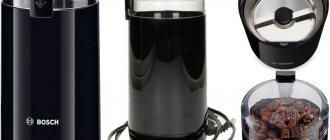Only true gourmets can appreciate the extraordinary taste of spices ground before serving the dish. This result is obtained when using home manual or electric mills.
They are miniature representatives of flour plants. Mills were first used to grind coffee beans, and later they were used to grind lumps of salt and sugar.
This happened more than 200 years ago, and since then these convenient devices have changed in appearance and functionality: you can adjust the degree of grinding, some models are battery powered, others are manual, mills are available with backlighting and an unusual design.
Principle of operation
Home mills, like their ancestors, have millstones inside - grinding circles. One is fixedly fixed, and the second, rotating, grinds spices, which are poured into the upper container. Mills can be divided into several types.
Disposable
A container filled with one of the spices or a mixture. It is made of glass or plastic. To grind, you need to twist the top cover. The advantages of this model include compactness and low cost. But such a mill has a ready-made set, so when it runs out, you will have to buy a new device.
Manual and mechanical
The devices consist of a flask, millstones and a container for ground spices. To start the mechanism, a handle or a movable upper part may be located on top. There are specimens specifically designed for pepper: the millstones have two rows of teeth that collect all the peas and grind them thoroughly.
For hard salt crystals, the millstones in the mill must be made of particularly strong material. Such a device has an advantage over a disposable one, since you can make the mixture yourself and adjust the dosage for grinding.
A mechanical mill is selected to match the design of kitchen utensils. The body of the device can be made of wood, stainless steel, ceramics or acrylic. There are different models, for example, “Molinero”, consists of 4 containers with spices. The lower part is used for grinding.
Rechargeable and battery-powered
A battery- or battery-powered mill can easily handle any solid particles. The engine is started using a button. There is a double-sided model made in the shape of an hourglass. A different type of spice is poured into each container. Such devices have a high price.
You need to know that the wooden body absorbs odors and is not recommended for oily seasonings.
When choosing a mill, you should pay attention to what material the millstones are made of. For hard spices, they should be made of steel or ceramic. It is worth noting that millstones with two rows of cutters are more reliable, and ceramics are suitable for spicy and dry herbs.
Features of using a reusable mill
A reusable (mechanical or manual) mill is suitable for aesthetes and gourmets. It usually consists of several components: a container where spices are poured, millstones or knives that grind spices and a container where the finished crushed spices are located. There are a huge number of types of such salt and pepper mills. They are universal or for only one type of seasoning, which in turn ideally chop peas. Universal grinders have stronger burrs for grinding salt, with and without different handles on top. Mechanical mills can be found in a variety of materials: wood, ceramics, plastic, steel, etc.
The advantages of a manual mill are its durability; you can choose a pepper grinder to suit every taste and any design: classic ceramic, modern stainless steel - everyone can choose an individual grinder. Some people like the process of manual grinding, while others consider this kind of grinding to be real. Often such mills can be found abroad. Very often, such devices are offered to be brought home from abroad as a souvenir.
And such a practical mill has its drawbacks: if you decide to buy it abroad, be careful that it does not turn out to be a souvenir in the literal sense of the word. Inspect the millstones to make sure they are not made of plastic; the best ones are metal ones. Please note that a wooden case is impractical and will absorb excess odors from other seasonings. Another disadvantage is the lack of adjustment of the grinding degree and the inability to grind coarse spices, and the most significant disadvantage is that this manual design is not suitable for grinding several seasonings in a row. Before grinding each seasoning, such a device should be washed. The cost of such a device ranges around 300 rubles.
What material is used
Acrylic or ABS plastic has a bright color. This material does not absorb aromas and does not allow moisture to pass through. The latter is a negative point, since wet spices caught in such a container can spoil. Acrylic is harmless and can be washed with water or wiped with a damp sponge. It is not advisable to leave a mill made of such material in the sun - the acrylic may fade.
Glass has properties similar to plastic, but this material is more fragile.
A wooden device has a noble appearance, but the spices inside such a container absorb odors well, so wooden models can only be used for one spice.
Wood is not recommended for oily seasonings. The surface of a wooden mill can be varnished. It is also advisable to avoid greasy stains.
Ceramic and stainless steel appliances are more reliable. There are also very elegant and beautiful specimens made of earthenware and porcelain. Steel mills are chosen by lovers of high-tech style.
Popular manufacturers
Peugeot
It is the oldest manufacturer of spice mills. The company has patented a special formula for the production of double-row, toothed millstones. The essence of the method is the spraying of metal vapors in a vacuum, which makes the teeth especially strong and sharp. This mill can easily handle hard crystals and grains and is also very durable.
Nuova Cer
The Italian company produces stylish and functional pepper mills. Ceramic models look especially elegant.
Legnoart
Another company from Italy, known for producing kitchen utensils of excellent quality with an elegant appearance. The body of the spice mill is made of ash or porcelain. The wood is preliminarily subjected to heat treatment in the form of heating in the range of 180-230̊ C. As a result, the material becomes resistant to temperature changes and moisture.
In the mill, metal millstones are arranged in two rows.
Cole&Mason
If you want to purchase a mill with a lifetime guarantee, then you should pay attention to the British company Cole&Mason.
The body of the product is made of metal or plastic, easy to use and has a modern look. The grinder provides six grinding modes.
The popularity of the brand is evidenced by the fact that the Walt Disney Company offered a license to use images of its characters.
BodumTwin
The Swiss company BodumTwin, famous for creating a French press for brewing tea, has in its collection a mill capable of grinding salt and pepper at the same time. At the same time, the lid also serves as a switch between spices. The mill body is made of glass or steel, and the millstones are made of ceramics.
Bisetti
Mills from the Italian manufacturer Bisetti are elegant models with a vintage touch. The body can be made of acrylic or wood: beech or olive. This material is able to preserve the smell of herbs and spices. If each type of spice has its own grinder, then you can enjoy the smell without foreign impurities.
Salt in a wooden case will always be dry, while acrylic as a material is ideal for aromatic spices. It does not absorb odors and does not react with essential oils.
The transparent surface allows you to control the amount of spices.
Housing material
The best material for the body of a hand mill is wood. The most popular raw materials for these purposes today are beech, pine, and linden. The production of such household kitchen appliances is carried out by both famous manufacturers (for example, German companies) and folk craftsmen. Professional products have a longer service life, since the raw materials undergo additional processing with special compounds, wax, and natural oils. A hand-held grain mill may have a cedar or other sturdy wood finish.
The use of wooden materials determines not only environmental friendliness, practicality and the necessary hygienic characteristics of the product, but also the fight against noise. If the model is manufactured correctly, the noise level during operation should not exceed 72 dB.
Cheaper options are mills made of veneer, plastic, glass, and ceramics. However, such materials have insufficient resistance to mechanical damage, are unreliable and therefore have a short service life. In addition, low-grade plastic is able to absorb odors and retain them for a long time.
There are also metal models that are resistant to mechanical stress and, due to their significant weight, physically facilitate the grinding process. However, such material is not an environmentally friendly raw material.
Wooden
Plastic
Glass
Metal
The best spice grinders
Paris Laque Blanc – stylish for salt
An elegant lacquered white accessory for salt is offered by the French company Peugeot. Steel grinders will help you deal with hard sea salt crystals and peppercorns. The mill is equipped with a U'Select grinding system: by turning the upper part of the body, you can select the required degree of grinding.
The height of the product is 12 cm, but there are taller models.
- Country: France
- Cost: 3570 rub.
mill Paris Laque Blanc
Advantages:
- beautiful;
- comfortable;
- 100% guarantee.
Flaws:
- not identified.
Peugeot Paris electric – expensive chic
The elegant and recognizable silhouette of a wooden mill hides a powerful electric motor inside. The mechanism runs on lithium-ion batteries. The kit includes a charger. The charging connector is located in the upper (closed) part of the product, and the indicator is also located there. The mill is equipped with a 6-stage grinding system. Height – 34 cm.
Cost – 9900 rub.
mill Peugeot Paris electric
Advantages:
- innovation model;
- lifetime warranty;
- high-quality case material: black lacquer, light wood;
- 20 g of pepper as a gift from the company.
Flaws:
- Expensive.
Gefu Aromatico – German quality
The mill from the German company Gefu is distinguished by its quality and durability. The body is made of plastic, and the millstones are ceramic, which are launched using a curved handle. The mill comes with 6 stickers with the names of spices. Height 9 cm. Country – Germany. Price – 3600 rub.
mill Gefu Aromatico
Advantages:
- high quality;
- convenient to use;
- a lid covering the bottom;
- transparent body.
Flaws:
- high price
Legnoart – the embodiment of Italian taste
The mill of the Italian company is an elegant, convenient and functional kitchen utensil. The body is made of ash, and the surface is processed manually using biomaterials. Wood does not absorb odors and moisture, and also does not dry out. The accessory is available in light shades and wenge colors. Ceramic millstones are capable of grinding solid particles, adjustable grinding. Country – Italy. Price – about 3000 rubles.
mill Legnoart
Advantages:
- interesting design;
- handmade;
- grinding adjustment.
Flaws:
- not detected.
Wesco - new product from the German brand
The mill is equipped with a CrushGrind mechanism, allowing for a grinding range from fine to coarse. To set the degree of grinding, there is a rotating metal wheel on the body. Ceramic millstones ensure durability of the product. The mill is easy to clean, the spice container is made of acrylic. Height – 10 cm. Country – Germany. Price – 3750 rub.
Wesco mill
Advantages:
- functional;
- elegant design;
- durable;
- easy care.
Flaws:
- not detected.
Bodum Twin – salt and pepper at the same time
The mill has not only an interesting design, but also unusual functionality. The glass container contains pepper and salt, and by pressing a button you can pepper and salt your food at the same time. For convenience, the upper part is made of colored silicone. The device is sold with spices inside. Country: Switzerland.
Price – 4200 rub.
mill Bodum Twin
Advantages:
- compact;
- ceramic millstones;
- different types of colors.
Flaws:
- weight 350 g – a bit heavy;
- high price.
Mallony Piccante – a model accessible to everyone
The mill has a clear acrylic body with a simple design. The millstones are ceramic. This model is suitable for any design - simple and compact. The degree of grinding is regulated by the lid on top.
The cost of the model is 460 rubles.
mill Mallony Piccante
Advantages:
- simple design;
- affordable price.
Flaws:
- no cover for the bottom
Richmond Buzz - convenient, modern, reliable
The English company Cole & Mason was the first to produce a plastic pepper grinder in 1975. The Richmond Buzz mill is made of steel with acrylic inserts. Millstones made of steel will last forever. The mechanism is started by pressing a button, because it is an electric device. The grinding mode switch and the power button are conveniently located. Runs on regular batteries.
Country: Great Britain. Price – 4650 rubles.
Richmond Buzz Mill
Advantages:
- modern design;
- convenient inclusion;
- several grinding modes.
Flaws:
- high price;
- 6 batteries required.
Hotter KDL-546 – just tilt it
This Russian-made mill will surprise you with the way it works: when tilted at 45°, the grinding process automatically starts. The spices are located at the top of the device, which prevents dust from getting on the table. You can change the grind size using the button. When the mill is turned on, the backlight lights up. The millstones are made of ceramic and can grind large particles. Country of origin: Russia.
Cost – 900-1400 rubles.
mill Hotter KDL-546
Advantages:
- durable body made of glass and plastic;
- ceramic millstones;
- interesting design.
Flaws:
- runs on 6 batteries, which are not included.
Tescoma President 2 in 1 – compact and stylish
The Czech manufacturer's spice grinder is small in size, but despite this it has two containers - for pepper and salt. To collect leftovers, the kit includes a lid that can be used to fill the container with spices. Ceramic millstones and a powerful motor powered by 6 batteries help to quickly grind any crystals.
Country: Czech Republic. Cost – 3200 rubles.
mill Tescoma President
Advantages:
- housing made of stainless steel and durable plastic;
- grinding degree adjustment;
- warranty – 5 years.
Flaws:
- Spices cannot be crushed;
- no batteries included
AIHOME – stylish simplicity
An innovative hand mill made in China will decorate any table. The gadget is made of high quality stainless steel. Grinding is started by pressing a button located at the top of the housing.
Country – China. Price – from 770 rubles.
mill AIHOME
Advantages:
- stylish design;
- ease of use;
- affordable price.
Flaws:
- not detected.
Types of hand mills
The models of hand mills offered today contain quite a lot of differences, both in functional purpose and in the quality of the materials from which they are made. The most universal options, in addition to the minimum set of functions, may contain additional elements that allow, for example, simultaneous grinding and flattening. If the set comes with a grain press, it becomes possible to prepare flakes.
By purpose
The main division of hand mills by purpose is their intended use:
- for preparing flour;
- for grinding spices.
From the corresponding cereals (corn, rice, buckwheat, barley and others), as well as legumes (peas, beans, beans), by hand grinding you can obtain substances of both large and small fractions, depending on the recipe recommendations. The possibility of obtaining such fractions is especially valuable for dietary purposes. So, if you need to prepare confectionery products, you should resort to the finest grinding. For porridges, soups, casseroles, and certain complex fillings, it is better to prepare medium or large fractions, preserving as much as possible the set of nutritional properties and vitamins.
Typically, such mills are equipped with a special sieve (for the purpose of cleaning the resulting fractions from large particles). Ultimately, the specific gravity of the finished product is 80%. This is flour of uniform consistency with particle size depending on the initial characteristics of the grain.
The most relevant today are millstones made from an alloy of corundum and ceramics. It is reliable, durable, rational. Optimum wear resistance is ensured at a relatively inexpensive price.
Grinding spices using hand mills can be done before preparing a dish, immediately at the time of serving, or for temporary storage. In the latter case, specific organoleptic properties are gradually lost, that is, the spices “dissipate.” To preserve the original zest and brightness of taste, it is better not to resort to this storage method.
It should be remembered that it is not recommended to grind spices based on oilseed components or spices in a hand mill (for example, nuts, mustard, sunflower seeds, flax seeds). This is explained by the fact that oily deposits accumulate on the millstones, clogging them and preventing further efficient operation. If this is still necessary, it is worth mixing the oilseed crop, for example, with grain or flakes.
For flour
For spices
By functionality
If we talk about the functionality of devices, they can be divided into the following types:
- disposable;
- reusable.
Since it is optimal to grind grains and spices immediately before using them, for the convenience of users, components are now commercially available already placed in so-called disposable manual grinders. More often they are made of glass, food-grade plastic, less often - wood, metal. The principle of operation of such a device is simple: by turning the lid clockwise, freshly ground ingredients fall into a plate or pan through the holes made in it. As the entire mass inside is crushed, the empty container is disposed of.
These mills are small in size, their shape is convenient to grasp with the hand, they are easy to clean externally, and have a stable base. A positive feature of such an item is the benefits of freshly ground products. However, naturally, the price of the components to be crushed is significantly higher than buying them in regular weight packaging.
Reusable mills are sold without filling. They have special holes for filling and consist of a knife (millstones) and a container for the crushed product. Manufacturing materials are very different, from wood of fragrant species to high-quality food steel. The operating mechanism is similar to single-use models, with the difference that the resulting product is poured into a storage container.
The internal parts of such models are more practical than those of disposable ones; they are designed for successful operation over a certain period of time. However, depending on the hardness of the products being ground, a change of millstones is still provided. Yes, and the body can receive mechanical damage.
When using reusable mills for multi-profile work, their mechanisms should be thoroughly cleaned so that the remnants of the previous grinding do not get into the new flour, transmitting their odors and tastes.
Reusable
Disposable











